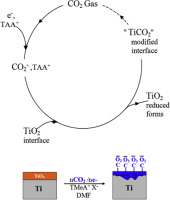Electrochemistry Communications ( IF 4.7 ) Pub Date : 2018-01-31 , DOI: 10.1016/j.elecom.2018.01.007 Jacques Simonet

|
Titanium covered with a thin layer of titanium dioxide was reduced in aprotic polar solvents (dimethylformamide or acetonitrile) saturated with carbon dioxide in the presence of tetraalkylammonium salts (TAAX). When using tetramethylammonium salts CO2 is irreversibly reduced at potentials < −1.6 V vs. Ag/AgCl/KClsat, generating an inactive surface down to −3.2 V. Anodic oxidation of the modified surface in the same solvent led to regeneration of a titanium interface free of oxide. Employing other TAAX salts permits reversible reduction of CO2 (Ep/2 = −2.21 V in the presence of TBuABF4). Under conditions of total passivation of the Ti surface followed by sonication, stable electrode surfaces inactive in organic polar solvents between −3 V and +2 V were obtained. Within the cathodic range, several organic π-acceptors were reversibly reduced down to −3 V, which shows the potential of such “Ti-CO2” surfaces as new working electrodes.
中文翻译:

钛的电化学羧化生成通用的新界面
在四烷基铵盐(TAAX)的存在下,在被二氧化碳饱和的非质子极性溶剂(二甲基甲酰胺或乙腈)中还原覆盖有二氧化钛薄层的钛。当使用四甲基铵盐时,在相对于Ag / AgCl / KClsat的电势<-1.6 V时,CO 2会不可逆地还原,从而产生低至-3.2 V的无活性表面。在同一溶剂中对改性表面进行阳极氧化会导致钛界面的再生不含氧化物。使用其他TAAX盐可 在存在TBuABF 4的情况下可逆地还原CO 2(E p / 2 = -2.21 V)。在对Ti表面进行完全钝化然后进行超声处理的条件下,获得了在-3 V和+2 V之间的对有机极性溶剂无活性的稳定电极表面。在阴极范围内,几种有机π受体可逆地降低至-3 V,这表明这种“ Ti-CO 2 ”表面作为新的工作电极的潜力。











































 京公网安备 11010802027423号
京公网安备 11010802027423号